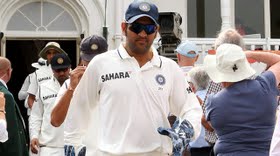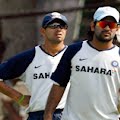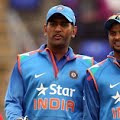By Garfield Robinson
India fell to embarrassing defeat by ten wickets against England at the Wankhede Stadium on the morning of the fourth day. There was something poetic about England’s victory: consider the fact that India’s highly regarded captain, Mahendra Singh Dhoni, requested and received a surface to facilitate his spinners, only to see the opposition’s spinners exploiting those conditions to defeat his team.
This defeat should be especially embarrassing for India because by batting first they got first use of a surface that only deteriorated thereafter. In other words, they batted when it was best for batting and had the opportunity to bowl to England when the pitch would be at its worst.
 If you really wanted to rub it in, you could say that Dhoni and his side were caught in a trap they themselves had set,or that they fell on their own sword, for they had added the spin of Harbajhan Singh to complement the dominance that Ravichandran Ashwin and PragyanOjha had exerted in the first test. They seemed to never have entertained the thought that England’s slow bowlers were also of high quality and would themselves revel in the conditions that were designed to overpower them.
If you really wanted to rub it in, you could say that Dhoni and his side were caught in a trap they themselves had set,or that they fell on their own sword, for they had added the spin of Harbajhan Singh to complement the dominance that Ravichandran Ashwin and PragyanOjha had exerted in the first test. They seemed to never have entertained the thought that England’s slow bowlers were also of high quality and would themselves revel in the conditions that were designed to overpower them.
India has relied heavily on spin in the past. Most notably in the 1960s and 70s when Bishen Bedi, Erapalli Prasanna, S. Venkataraghavan and Bhagwat Chandrasekhar formed a formidable four-man spin attack that was employed in all conditions. That was almost 40 years ago, however, and there is no way that a team similarly constituted could hope to be competitive all over the cricketing world today. And even then India did not win many away tests.
Horses for courses is fine but it is difficult to say to a group of young pacers like Ishant Sharma, Varun Aaron and Umesh Yadav that they are surplus to requirements at home and then expect them to do the business when they travel abroad. This approach also presupposes that visiting teams will not be blessed with spinners as adept in these treacherous conditions as those of the home team, and that the visiting batsmen will be unable to cope in such hostile conditions. Well, the batting of Alastair Cook and Kevin Pietersen and the bowling of Graeme Swann and Monty Panesar have now turned that theory on its head.
The England Captain has been batting as well as any batsman who ever visited the subcontinent, and Pietersen’s outrageous gifts were on show as he dominated the Indian spinners in a manner that must have seemed inconceivable. The England spinners, meantime, totally outbowled their Indian counterparts. While the host’s slow bowlers were often too short, allowing Pietersen and Cook to wait on the back-foot on slow-turning deliveries, Swann, and Panesar especially, were fuller in length and quicker through the air, and consequently more demanding. No Indian batsman, save Gautam Gambhir, could construct a competent reply.
There may be a lesson to be learned here for India: trying to persecute opponents on raging turners can backfire if your opponents posses quality spinners of their own. Not only that, this kind of approach, taken to its extreme, is shortsighted. India will almost always be favourites to win at home, but such surfaces will restrict the development of India’s swing and seam bowlers, just like it happened those many years ago when the all-spin attack was never-ending. Also, batsmen whose skills have been honed on low bouncing turners will be ill-equipped to handle the pace and bounce they will often encounter abroad.
It was once accepted wisdom (may be it still is in some quarters) that the way to overcome India was to catch them on a spicy surface and get the ball up around their batsmen’s ears. Players like Tendulkar, Dravid, Laxman and Ganguly did a lot to scupper those beliefs, while bowlers like Anil Kumble, Harbajhan Singh and Zaheer Khan with occasional assistance from others like Shanthakumaran Sreesanth and Ishant Sharma were good enough to take 20 wickets on foreign soil and so enable them to win games. But though Cheteshwar Pujara and Virat Kohli have shown a lot of ability, the team has been obviously hurt by the retirement of Dravid and Laxman and the diminution of Tendulkar’s powers. Their challenges going forward will be considerable.
India’s recent experiences abroad were not happy ones. Whitewashed by both England and Australia, their desire to exact revenge is understandable. But revenge, especially when it involves a reliance on conditions that will not be replicated any place else, is not a strategy for long-term improvement, and will do little to help Dhoni’s side in getting back to the top of the pile. If India wants to develop players to do well abroad they will have to cultivate them at home.














